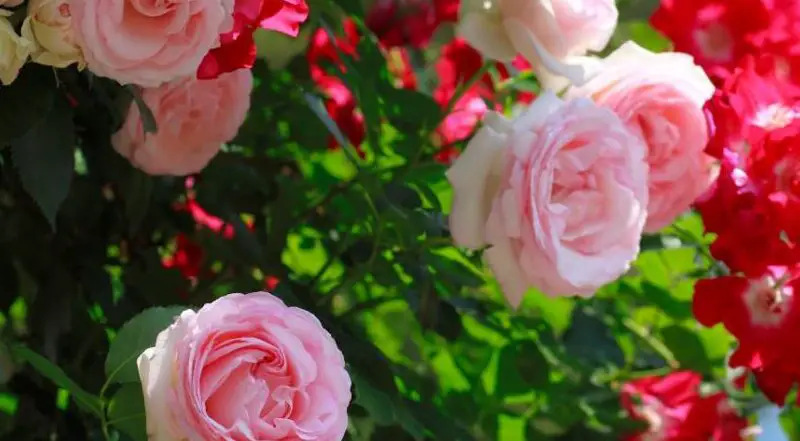You want to have roses for your garden, or you already have some, but you don’t know how to maintain them, how to prune them? We will take some time together to explain. Pruning roses is above all about taking the time to observe your rosebush.
Contents
Maintenance of roses according to the seasons
Pruning roses in spring
The “usual” pruning of roses is done in spring, in February or March depending on the region. The most important thing is to wait until after the frosts. The pruning commonly used is the “3 eyes pruning”. It consists in cutting the branch at about 0.5 inch above the third eye.
Care of roses before winter
Fall pruning is optional, and only complementary to Spring pruning. Indeed, if you prune the branches in autumn, the young shoots that will appear after the pruning will be sensitive to cold. It is therefore better to wait until the frost is over.
However, you can pre-prune your roses in the fall before the spring pruning. This involves shortening the shoots with gray-green bark, and freeing the branches from the center of the rosebush. Remove branches, flowers and dead leaves (they carry diseases, so it is advisable to burn them).
Watering and fertilizing
The roses marketed by Meilland Richardier are remontant. This means that the roses bloom from May to frost. For this reason, the rosebush must have enough water and fertilizer during this period of vegetation.
Watering
Water preferably at the base of the rose and avoid wetting the foliage. In light soil, water frequently (e.g. twice a week). In heavy soil, which retains water better, water more sparingly (e.g. once a week).
Fertilizers
You can use the same types of fertilizers as before planting, or fertilizers richer in nitrogen (N).
A fertilizer application after each flowering is recommended.
Why prune roses?
To obtain beautiful roses with abundant flowers, it is essential to prune them. The removal of damaged or dead branches stimulates the plant’s vegetation, but also maintains an aesthetic shape and good phytosanitary condition.
When to prune roses?
Pruning stimulates vegetation, so the shorter you prune, the stronger the rosebush will be the next time it grows. To avoid making a mistake, remember the following rule:
Prune vigorous roses long (5 to 9 eyes) to calm their ardor, and prune stunted roses short (3 eyes) to stimulate them.
How to prune roses?
How to prune a climbing rose?
For climbing roses, prune the large branches by arching them to give your rose a balanced shape.
Remove large branches that are too old or dead. Prune the secondary branches to 4/6 inches.
How to prune a bush rose, a bedding rose, a Queen Elizabeth rose or an English rose?
Bush, bedding, Queen Elizabeth and English Roses are pruned in the same way. Simply cut back all the stems to a height of about 6 to 10 inches from the grafting point, leaving 3 to 5 buds per stem, depending on its vigor: the stronger the stem, the more buds should be left.
How to prune a rosebush on a stem?
At the end of autumn, after the last flowers have bloomed, stem roses (and miniature stem roses) require some maintenance. Shorten the branches slightly to allow you to protect the head with a jute bag or better with the wintering sails sold in the catalog.
Large flowered stem roses should be pruned short (6 to 8 inches from the head graft). Weeping roses and Excelsa type roses just need to be cleaned up (dead, sickly, broken branches…). Beware of suckers growing at the base or on the trunk: eliminate them.
How to prune shrub roses and old roses?
Shrub roses and old roses must keep their natural bushy shape. Pruning therefore consists of eliminating dead wood and badly placed stems and slightly shortening the others.
How to prune miniature roses?
For miniature roses, a simple cleaning is enough. Remove dead wood, twigs and wilted flowers.
How do I prune botanical roses and ground cover roses?
For botanical roses and ground cover roses, pruning is not necessary unless they become too bulky.
How to prune drooping roses?
For drooping roses, simply aerate the branch by removing some of the excess stems.
How to protect your roses during winter?
Roses need winter protection. This is necessary in certain regions with very cold winters and applies mainly to mini-roses and stemmed plants.
Winter protection for roses on stems
Protect the head of stemmed roses with winter covers.
Winter protection for miniature roses
Cover your miniature roses with straw or a winter cover
Controlling rose diseases and pests
Black spot disease (marsonia), rust or powdery mildew do considerable damage to certain varieties of roses. Be aware that it is difficult to eradicate a fungal disease once it has broken out. Do not overuse chemical treatments, which are harmful to the environment and to the insect helpers. Only intervene if the attack is severe.
Prefer a sulfur-based treatment to synthetic molecules to fight against powdery mildew. To prevent the appearance of marsonia, spray twice with Bordeaux mixture: in November when the leaves fall to kill the pathogenic germs, then in March after pruning to help the healing of the cuts.
By avoiding mineral deficiencies (magnesium and potassium, in particular), the resistance of roses is strengthened. You can also stimulate their natural defenses with horsetail or nettle purin used as a foliar spray (read: Nettle and comfrey purins: it works!). The latter also has anti-chlorotic properties.
To get rid of aphid colonies, which are numerous in spring, count on the action of auxiliary insects (ladybugs, lacewings) and if the infestation is important, think of black soap diluted in water. Accompany your roses with plants such as lavender, whose aromatic scent has a repulsive effect on many pests.









